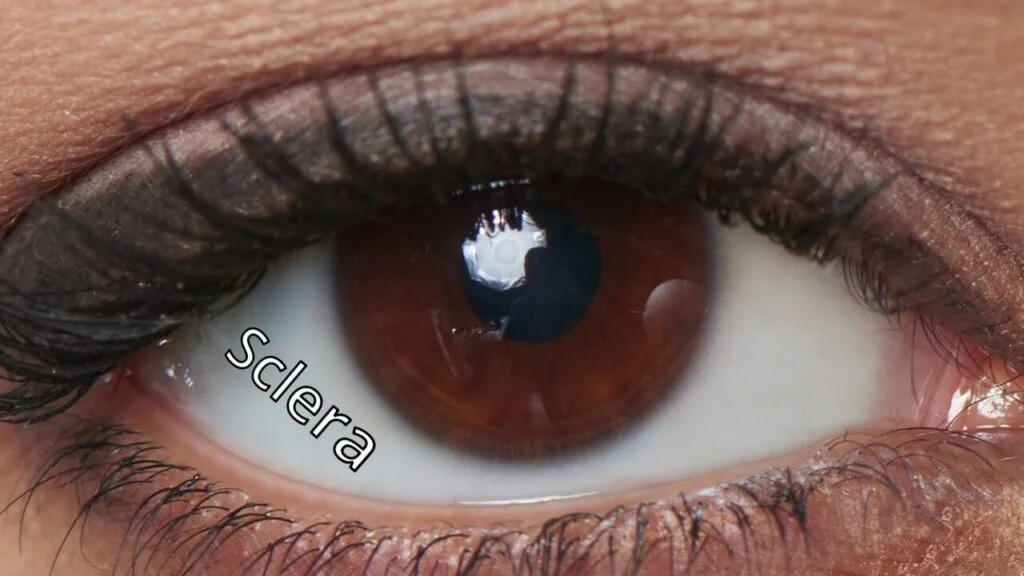What is the Sclera?

Introduction to Sclera
The white part of the eye – that makes up the majority of the external visible part of the eye – is called the sclera. The first part of the word “scler-” means hard, as the full word “sclera” is referencing a “hard” membrane. The sclera receives this label because it is formed from very strong criss-crossing collagen tissue that gives the eye its shape, provides attachment for extraocular muscles, and protects the inner tissues of the eye from injury.
The sclera, along with the cornea (the clear dome over the color part of our eye – the iris), form the fibrous outer layer of the globe of the eye.
Role of Sclera in Vision
The criss-crossing design of the collagen makes the sclera white and opaque (light can not pass through it). This opacity is important for the eye to properly regulate the amount of light that enters the eye. Even though the sclera is actually made up of the same collagen tissue as the cornea with which it is consistent, the cornea is transparent because the collagen fibers are aligned precisely when the necessary state of hydration of the cornea is maintained. Therefore, the only light that can pass through the fibrous outer layer of the globe must pass through the cornea.
Sclera and Contact Lenses
For our best vision, light must pass through the cornea, the pupil, the lens, the vitreous, and focus on the fovea (which is the point of our sharpest vision on our retina). When an eye doctor is fine tuning your prescription glasses or contact lenses, they are trying to focus light directly on the fovea.
Vision problems, such as hyperopia, myopia, and astigmatism, improperly focus light and cause the fovea to receive a blurred image. Your prescription is a measurement in diopters of how far the off-focus point in your eye must be moved to focus light directly on the fovea. Contact lenses are designed to correct these off-focus points, called refractive errors, ensuring that light entering the eye is ultimately focused directly on the fovea.
A well-fitted contact lens ensures that the image is sharply focused onto the retina’s fovea, providing clear central vision. However, most soft and rigid gas permeable (RGP’s) contact lenses barely overlap onto the sclera and fit directly onto the cornea instead.
In cases where significant corneal irregularities occur, such as corneal ectasia (like keratoconus) and severe ocular surface diseases (like Stevens-Johnson syndrome), typical soft contact lenses and RGP’s have limited effect and may create greater issues. Therefore, a lens that rests entirely upon the conjunctival tissue that overlies the sclera is employed, and is called a scleral lens. This type of lens vaults the cornea and creates a pool of fluid to bathe the cornea and creates a smooth new combination of “tears + cornea” optical surface for light to pass. These lenses, though large, tend to be comfortable when fit correctly, but also tend to be expensive to fit. Again, these lenses are designed to be used to treat less common corneal irregularity issues.
Common Sclera-Related Issues
- Jaundice: “yellowing of the sclera” that occurs when bilirubin levels are high, and is often linked to liver disease. However, the white sclera only appears yellow, but it is not actually the sclera that turns yellow. Instead, it’s the overlying and normally transparent conjunctiva that accrues the bilirubin deposition that casts the yellow appearance of the sclera.
- Blood and dilated vessels on the sclera: blood spots or vessels that appear over the sclera are actually not the sclera itself. They are typically dilated or broken blood vessels of the “normally transparent” conjunctiva or episclera that are both over the sclera.
- Brown spots on the sclera: brown spots are usually simple pigmentations (freckles) that occur on the normally clear conjunctiva, but appear as if they are brown spots on sclera.
- Blue/Grey spots on the sclera: blue spots can occur where the sclera is thin naturally, due to age, or in cases of bone or connective tissue disorders.
- Scleritis: severe inflammation of the eye that occurs associated with autoimmune diseases.
Eye Health Tips Specific to Sclera
Since most of the true problems with the sclera are associated with other problems like inflammatory disease, the best way to keep the sclera healthy is to avoid or control the underlying disease. In other words… “Eat Healthy, Drink Healthy, Be Healthy,” though sometimes easier said than done.
Need Consistanly Cheap Contacts?
DeliverContacts.com always guarantees you are paying low prices, every time you buy. We will never play games with our pricing or take part in manipulative discounts. Just consistently cheap contacts, forever.
Give your box a search below and see for yourself! 100% Free shipping and returns on all products!
